STIHL HL 100 Owner's Manual
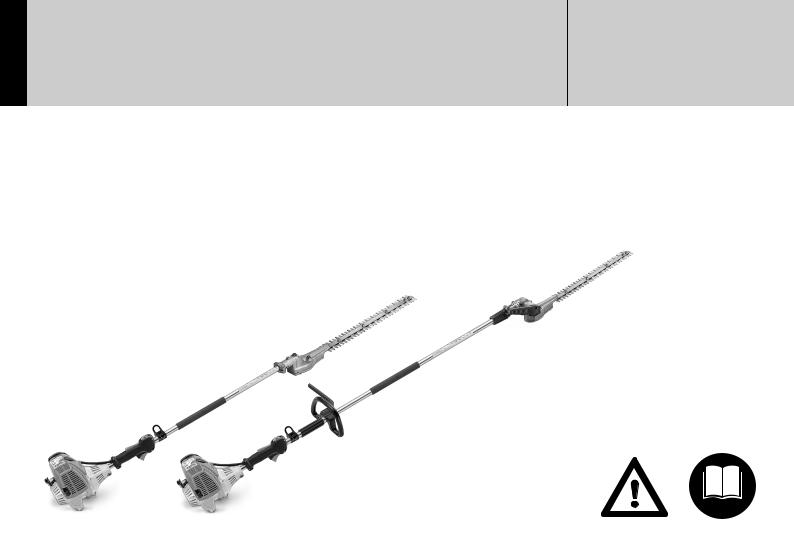
STIH)
STIHL HL 100
Instruction Manual Manual de instrucciones
Warning!
Read and follow all safety precautions in Instruction Manual - improper use can cause serious or fatal injury.
Advertencia!
Lea y siga todas las precauciones de seguridad dadas en el manual de instrucciones - el uso incorrecto puede causar lesiones graves o mortales.
Contents
09.fm |
|
Guide to Using this Manual .............. |
2 |
|
|
Safety Precautions and |
|
||
002 01 |
|
Working Techniques ......................... |
3 |
|
|
Approved Power Tool |
13 |
||
140_ |
|
Attachments .................................... |
||
|
Assembling the Unit |
14 |
||
SE_ |
|
|||
|
Using the Hedge Cutter |
15 |
||
_ |
|
|||
BA |
|
4-MIX Engine |
17 |
|
|
|
|||
|
|
Fuel ................................................ |
18 |
|
|
|
Fueling ............................................ |
19 |
|
|
|
Adjusting Cutter Bar ....................... |
20 |
|
|
recycled. |
Fitting the Harness ......................... |
22 |
|
|
Starting / Stopping the Engine |
22 |
||
|
|
|||
|
|
Operating Instructions .................... |
25 |
|
|
can be |
Cleaning the Air Filter ..................... |
25 |
|
|
Motor Management ........................ |
26 |
||
|
paper |
Adjusting the Carburetor ................ |
26 |
|
|
Spark Arresting Screen in Muffler |
28 |
||
|
oils; |
|||
|
Checking the Spark Plug ................ |
28 |
||
paper.free-chlorineon vegetablecontaininks |
Lubricating the Gearbox |
29 |
||
|
|
|||
|
|
Replacing Starter Rope |
|
|
|
|
and Rewind Spring ......................... |
30 |
|
|
|
Sharpening Instructions .................. |
33 |
|
|
|
Storing the Machine ........................ |
33 |
|
Printed |
Printing |
Maintenance Chart ......................... |
34 |
|
Main Parts and Controls |
36 |
|||
|
|
|||
|
|
Specifications ................................. |
38 |
|
|
|
Special Accessories ....................... |
38 |
|
|
in USA |
Maintenance and Repairs ............... |
39 |
|
|
STIHL Incorporated |
|
||
200KG, |
Federal Emission Control |
|
||
Printed. |
Warranty Statement |
40 |
||
|
|
|||
|
|
STIHL Incorporated California |
|
|
& Co. |
|
Exhaust and Evaporative Emissions |
|
|
|
Control Warranty Statement ........... |
42 |
||
© ANDREAS STIHL AG |
0458 388 8621 B. M |
STIHl |
|
|
|
|
HL 100 |
|
|
English / USA
Allow only persons who understand this manual to operate your hedge cutter.
To receive maximum performance and satisfaction from your STIHL hedge cutter, it is important that you read and understand the maintenance and safety precautions, starting on page 3, before using your hedge cutter.
Contact your STIHL dealer or the STIHL distributor for your area if you do not understand any of the instructions in this manual.
!Warning!
Because a hedge cutter is a high-speed cutting tool some special safety precautions must be observed to reduce the risk of personal injury.
Careless or improper use may cause serious or even fatal injury.
STIHL's philosophy is to continually improve all of its products. As a result, engineering changes and improvements are made from time to time. If the operating characteristics or the appearance of your hedge cutter differs from those described in this manual, please contact your STIHL dealer for information and assistance.
1
3.4. B9. CP
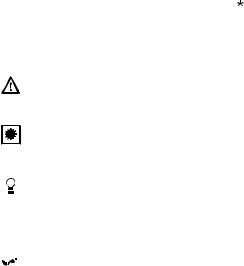
English / USA
Guide to Using this Manual
Pictograms
All the pictograms attached to the machine are shown and explained in this manual.
The operating and handling instructions are supported by illustrations.
Symbols in text
The individual steps or procedures described in the manual may be marked in different ways:
:A bullet marks a step or procedure without direct reference to an illustration.
A description of a step or procedure that refers directly to an illustration may contain item numbers that appear in the illustration.
Example:
Loosen the screw (1) Lever (2) ...
In addition to the operating instructions, this manual may contain paragraphs that require your special attention. Such paragraphs are marked with the symbols described below:
Warning where there is a risk of an accident or personal injury or
serious damage to property.
 Caution where there is a risk of damaging the machine or its individual components.
Caution where there is a risk of damaging the machine or its individual components.


 Note or hint which is not essential for using the machine, but may improve the operator’s understanding of the situation and result in better use of the machine.
Note or hint which is not essential for using the machine, but may improve the operator’s understanding of the situation and result in better use of the machine.

 Note or hint on correct procedure in
Note or hint on correct procedure in  order to avoid damage to the environment.
order to avoid damage to the environment.
Equipment and features
This instruction manual may refer to several models with different features. Components that are not installed on all models and related applications are marked with an asterisk (*). Such components may be available as special accessories from your STIHL dealer.
Engineering improvements
STIHL’s philosophy is to continually improve all of its products. As a result, engineering changes and improvements are made from time to time. If the operating characteristics or the appearance of your machine differ from those described in this manual, please contact your STIHL dealer for assistance.
Therefore some changes, modifications and improvements may not be covered in this manual.
2 |
HL 100 |

English / USA
Safety Precautions and
Working Techniques
Because a hedge trimmer is a high-speed, fastcutting power tool with
sharp cutting blades, special safety precautions must be observed to reduce the risk of personal injury.
It is important that you read, fully understand and observe the following safety precautions and warnings. Read the instruction manual and
the safety precautions periodically. Careless or improper use may cause serious or fatal injury.
Have your STIHL dealer show you how to operate your power tool. Observe all applicable local safety regulations, standards and ordinances.
!Warning!
Do not lend or rent your power tool without the instruction manual. Be sure that anyone using it understands the information contained in this manual.
!Warning!
The use of this machine may be hazardous. If the cutting tool comes in contact with your body, it will cut you.
Use your hedge trimmer only for cutting hedges, shrubs, scrub, bushes and similar material. It must not be used for any other purposes, since such misuse may result in an accident or damage to the machine.
!Warning!
Minors should never be allowed to use this power tool. Bystanders, especially children, and animals should not be allowed in the area where it is in use.
!Warning!
To reduce the risk of injury to bystanders and damage to property, never let your power tool run unattended. When it is not in use (e.g. during a work break), shut it off and make sure that unauthorized persons do not use it.
Most of these safety precautions and warnings apply to the use of all STIHL hedge trimmers. Different models may have different parts and controls. See the appropriate section of your instruction manual for a description of the controls and the function of the parts of your model.
Safe use of a hedge trimmer involves
1.the operator
2.the power tool
3.the use of the power tool.
THE OPERATOR Physical Condition
You must be in good physical condition and mental health and not under the influence of any substance (drugs, alcohol, etc.) which might impair vision, dexterity or judgment. Do not operate this machine when you are fatigued.
!Warning!
Be alert – if you get tired, take a break. Tiredness may result in loss of control. Working with any power tool can be strenuous. If you have any condition that might be aggravated by strenuous work, check with your doctor before operating this machine.
HL 100 |
3 |

English / USA
!Warning!
Prolonged use of a power tool (or other machines) exposing the operator to vibrations may produce whitefinger disease (Raynaud's phenomenon) or carpal tunnel syndrome.
These conditions reduce the hand's ability to feel and regulate temperature, produce numbness and burning sensations and may cause nerve and circulation damage and tissue necrosis.
All factors which contribute to whitefinger disease are not known, but cold weather, smoking and diseases or physical conditions that affect blood vessels and blood transport, as well as high vibration levels and long periods of exposure to vibration are mentioned as factors in the development of whitefinger disease. In order to reduce the risk of whitefinger disease and carpal tunnel syndrome, please note the following:
Most STIHL power tools are available with an anti-vibration (“AV”) system designed to reduce the transmission of vibrations created by the machine to the operator's hands. An AV system is recommended for those persons using power tools on a regular or sustained basis.
Wear gloves and keep your hands warm.
Keep the AV system well maintained. A power tool with loose components or with damaged or worn AV buffers will tend to have higher vibration levels.
Maintain a firm grip at all times, but do not squeeze the handles with constant, excessive pressure. Take frequent breaks.
All the above-mentioned precautions do not guarantee that you will not sustain whitefinger disease or carpal tunnel syndrome. Therefore, continual and regular users should closely monitor the condition of their hands and fingers. If any of the above symptoms appear, seek medical advice immediately.
!Warning!
The ignition system of the STIHL unit produces an electromagnetic field of a very low intensity. This field may interfere with some pacemakers. To reduce the risk of serious or fatal injury, persons with a pacemaker should consult their physician and the pacemaker manufacturer before operating this tool.
Proper Clothing
!Warning!
To reduce the risk of injury, the operator should wear proper protective apparel.
!Warning!
To reduce the risk of injury to your eyes never
operate your power tool unless wearing goggles or properly fitted protective glasses with adequate top
and side protection complying with ANSI Z 87.1 (or your applicable national standard). To reduce the risk of injury to your face STIHL recommends that you also wear a face shield or face screen over your goggles or protective glasses.
!Warning!
Power tool noise may damage your hearing.
Wear sound barriers (ear plugs or ear mufflers) to
protect your hearing. Continual and regular
users should have their hearing checked regularly.
Be particularly alert and cautious when wearing hearing protection because your ability to hear warnings (shouts, alarms, etc.) is restricted.
4 |
HL 100 |
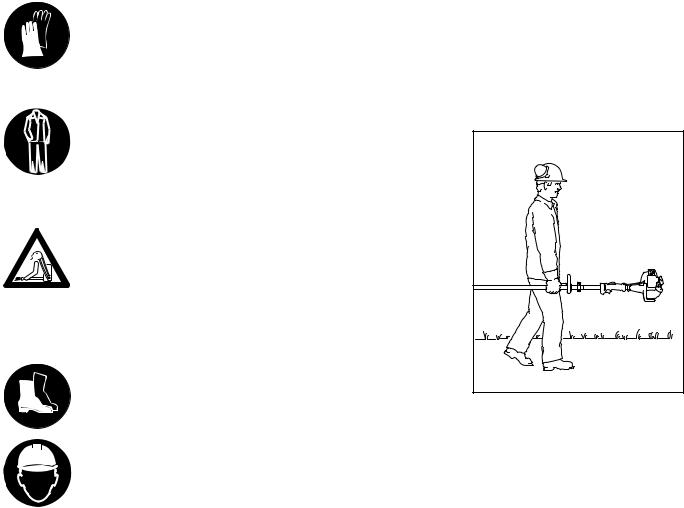
English / USA
Always wear gloves when handling the machine and the cutting tool. Heavyduty, nonslip gloves improve your grip and help to protect your hands.
Clothing must be sturdy and snug-fitting, but allow
complete freedom of movement. Wear long
pants made of heavy material to help protect
your legs. Do not wear shorts, sandals or go barefoot.
Avoid loose-fitting jackets, scarfs, neckties, jewelry,
flared or cuffed pants, unconfined long hair or anything that could become caught on
branches, brush or the moving parts of the unit. Secure hair so it is above shoulder level.
Good footing is very important. Wear sturdy boots with nonslip soles.
Steel-toed safety boots are recommended.
Wear an approved safety hard hat to reduce the risk of injury to your head when there is a danger of head injuries.
THE POWER TOOL
For illustrations and definitions of the power tool parts see the chapter on “Main Parts and Controls”.
!Warning!
Never modify this power tool in any way. Only attachments supplied by STIHL or expressly approved by STIHL for use with the specific STIHL model are authorized. Although certain unauthorized attachments are useable with STIHL power tools, their use may, in fact, be extremely dangerous.
If this tool is subjected to unusually high loads for which it was not designed (e.g. heavy impact or a fall), always check that it is in good condition before continuing work. Check in particular that the fuel system is tight (no leaks) and that the controls and safety devices are working properly. Do not continue operating this machine if it is damaged. In case of doubt, have it checked by your STIHL servicing dealer.
THE USE OF THE POWER TOOL Transporting the Power Tool
!Warning!
To reduce the risk of injury from blade contact, never carry or transport your power tool with the cutter blades moving.
389BA019 KN |
It may be carried only in a horizontal position. Grip the shaft in a manner that the machine is balanced horizontally. Keep the hot muffler away from your body and the cutting attachment behind you.
HL 100 |
5 |
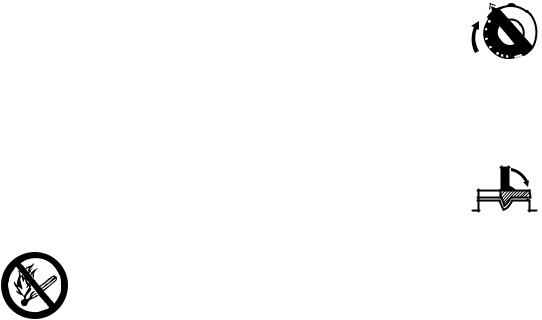
English / USA
!Warning!
Always switch off the engine and fit the scabbard over the cutter blades before transporting the power tool over long distances. When transporting it in a vehicle, properly secure it to prevent turnover, fuel spillage and damage to the unit.
On machines with an adjustable cutter bar: Make sure the cutter bar is secured in position. See chapter in instruction manual entitled “Adjusting Cutter Bar Angle.” On machines with a transport position: Move cutter bar to transport position and secure.
Fuel
Your STIHL power tool uses an oilgasoline mixture for fuel (see the chapter on “Fuel” of your instruction manual).
!Warning!
Gasoline is an extremely flammable fuel. If spilled and ignited by a spark or
other ignition source, it can cause fire and serious burn injury or property
damage. Use extreme caution when handling gasoline or fuel mix.
Do not smoke or bring any fire or flame near the fuel or the power tool. Note that combustible fuel vapor may escape from the fuel system.
Fueling Instructions
!Warning!
Fuel your power tool in well-ventilated areas, outdoors. Always shut off the engine and allow it to cool before refueling. Gasoline vapor pressure may build up inside the fuel tank depending on the fuel used, the weather conditions and the tank venting system.
In order to reduce the risk of burns and other personal injury from escaping gas vapor and fumes, remove the fuel filler cap on your power tool carefully so as to allow any pressure build-up in the tank to release slowly. Never remove the fuel filler cap while the engine is running.
Select bare ground for fueling and move at least 10 feet (3 m) from the fueling spot before starting the engine. Wipe off any spilled fuel before starting your machine.
!Warning!
Check for fuel leakage while refueling and during operation. If fuel leakage is found, do not start or run the engine until the leak is fixed and any spilled fuel has been wiped away. Take care not to get fuel on your clothing. If this happens, change your clothing immediately.
Different models may be equipped with different fuel caps.
Cap with grip
!Warning!
In order to reduce the risk of fuel spillage and fire from an improperly tightened fuel cap, correctly position and tighten the fuel cap in the fuel tank opening.
To do this with this STIHL
cap, raise the grip on the
top of the cap until it is
upright at a 90° angle. Insert the cap in the fuel tank opening with the
triangular marks on the grip of the cap and on the fuel tank opening lining up. Using the grip, turn the cap firmly clockwise as far as it will go (approx. a quarter turn).
Fold the grip flush with the top of the cap. If the grip
does not lie completely flush with the cap and the detent on the grip does not fit in the
corresponding recess in the filler neck, the cap is not properly seated and tightened and you must repeat the above steps.
6 |
HL 100 |

English / USA
Screw cap
!Warning!
Unit vibrations can cause an improperly tightened
fuel filler cap to loosen or
come off and spill
 quantities of fuel. In order to reduce the risk of fuel spillage and fire, tighten the fuel filler cap
quantities of fuel. In order to reduce the risk of fuel spillage and fire, tighten the fuel filler cap
by hand as securely as possible.
Before Starting
!Warning!
Always check your power tool for proper condition and operation before starting, particularly the throttle trigger, throttle trigger interlock, stop switch and cutting tool. The throttle trigger (if applicable) must move freely and always spring back to the idle position. Never attempt to modify the controls or safety devices.
!Warning!
Never use a power tool that is damaged or not properly maintained.
!Warning!
Check that the spark plug boot is securely mounted on the spark plug – a loose boot may cause arcing that could ignite combustible fumes and cause a fire.
Keep the handles clean and dry at all times; it is particularly important to keep them free of moisture, pitch, oil, grease or resin in order for you to maintain a firm grip and properly control your power tool.
!Warning!
The cutting tool must be properly tightened and in safe operating condition. Inspect for loose parts (nuts, screws, etc.) and for cracked, bent, warped or damaged blades. Regularly check the condition and tightness of the cutter blades – with the engine stopped! Replace damaged cutter blades before using the power tool. Always keep blades sharp.
STIHL recommends that you always spray the cutter blades with STIHL resin solvent before starting work - with the engine stopped! You can obtain this protective spray from your dealer. Apply generously.
Adjust carrying harness and hand grip to suit your size before starting work.
Starting
On machines with an adjustable cutter bar: Secure the cutter bar in the starting position as described in the chapter “Starting/Stopping the Engine.” If this starting position is not the desired cutting position, you will then need to carefully adjust the machine to the desired position once the engine has returned to idle and the blades are no longer moving.
On machines with a defined transport position (cutter bar folded against the drive tube): Never start the machine in the transport position, since the blades are not engaged in that position and you therefore cannot visually check to see that they will be stopped at idle when you start to adjust the cutter bar to the desired cutting position (where the blades are engaged).
Start the engine at least 10 feet (3 meters) from the fueling spot, outdoors only.
HL 100 |
7 |
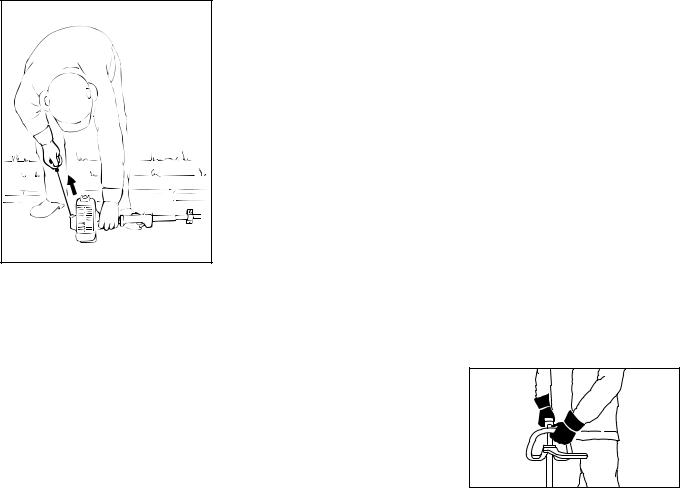
English / USA
389BA023 KN |
For specific starting instructions, see the appropriate section of your manual. Place the power tool on firm ground or other solid surface in an open area. Maintain good balance and secure footing.
!Warning!
To reduce the risk of injury from blade contact, be absolutely sure that the cutting tool is clear of you and all other obstructions and objects, including the ground, because when the engine starts at starting-throttle, engine speed will be fast enough for the clutch to engage and move the blades on the cutting tool.
Once the engine has started, immediately blip the throttle trigger, which should release the starting throttle and allow the engine to slow down to idle.
With the engine running only at idle, attach the power tool to the spring hook of your harness (see appropriate chapter of this manual).
!Warning!
Your power tool is a one-person machine. Do not allow other persons in the general work area, even when starting.
!Warning!
To reduce the risk of injury from loss of control, do not attempt to “drop start” your power tool.
!Warning!
When you pull the starter grip, do not wrap the starter rope around your hand. Do not let the grip snap back, but guide the starter rope to rewind it properly. Failure to follow this procedure may result in injury to your hand or fingers and may damage the starter mechanism.
Important Adjustments
!Warning!
To reduce the risk of personal injury from loss of control or contact with the running cutting tool, do not use your unit with incorrect idle adjustment. At correct idle speed, the cutting tool should not move. For directions on how to adjust idle speed, see the appropriate section of your instruction manual.
If you cannot set the correct idle speed, have your STIHL dealer check your power tool and make proper adjustments and repairs.
During Operation
Holding and controlling the power tool
Always hold the unit firmly with both hands on the handles while you are working. Wrap your fingers and thumbs around the handles.
002BA057 KN
Your right hand should grip the rear handle. This also applies to left-handers.
8 |
HL 100 |
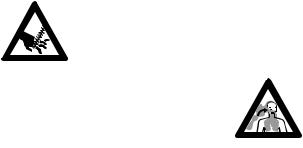
English / USA
!Warning!
Never attempt to operate your power tool with one hand. Loss of control of
the power tool resulting in serious or fatal injury may result. To reduce the risk
of cut injuries, keep hands and feet away from the cutting tool. Never touch a moving cutting tool with your hand or any other part of your body.
!Warning!
Do not overreach. Keep proper footing and balance at all times. Special care must be taken in slippery conditions (wet ground, snow) and in difficult, overgrown terrain. Watch for hidden obstacles such as tree stumps, roots and ditches to avoid stumbling. For better footing, clear away fallen branches, scrub and cuttings. Be extremely cautious when working on slopes or uneven ground.
!Warning
To reduce the risk of injury from loss of control, never work on a ladder, in a tree or any other insecure support. Never hold the machine above shoulder height.
Working conditions
Operate and start your power tool only outdoors in a well ventilated area. Operate it under good visibility and daylight conditions only. Work carefully.
!Warning!
As soon as the engine is running, this product
generates toxic exhaust fumes containing chemicals, such as unburned hydrocarbons
(including benzene) and carbon monoxide, that are known to cause respiratory problems, cancer, birth defects, or other reproductive harm. Some of the gases (e.g. carbon monoxide) may be colorless and odorless. To reduce the risk of serious or fatal injury/illness from inhaling toxic fumes, never run the machine indoors or in poorly ventilated locations.
!Warning!
If the vegetation being cut or the surrounding ground is coated with a chemical substance (such as an active pesticide or herbicide), read and follow the instructions and warnings that accompanied the substance at issue.
!Warning!
Inhalation of certain dusts, especially organic dusts such as mold or pollen, can cause susceptible persons to have an allergic or asthmatic reaction. Substantial or repeated inhalation of dust and other airborne contaminants, in particular those with a smaller particle size, may cause respiratory or other illnesses. Control dust at the source where possible. Use good work practices, such as operating the unit so that the wind or operating process directs any dust raised by the power tool away from the operator. Follow the recommendations of EPA/OSHA/ NIOSH and occupational and trade associations with respect to dust (“particulate matter”). When the inhalation of dust cannot be substantially controlled, i.e., kept at or near the ambient (background) level, the operator and any bystanders should wear a respirator approved by NIOSH/ MSHA for the type of dust encountered.
HL 100 |
9 |
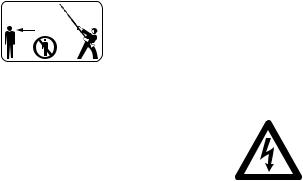
English / USA
Operating instructions
!Warning!
Do not operate your power tool using the starting throttle lock, as you do not have control of the engine speed.
In the event of an emergency, switch off the engine immediately – move the slide control / stop switch to 0 or STOP.
!Warning
The cutter blades continue to move for a short period after the throttle trigger is released (flywheel effect).
Accelerating the engine while the blades are blocked increases the load and will cause the clutch to slip continuously.
This may result in overheating and damage to important components (e.g. clutch, polymer housing components) – which can then increase the risk of injury from the blades moving while the engine is idling.
!Warning!
On units with an adjustable cutter bar: To reduce the risk of injury, never touch the blades while making adjustments.
The power tool has a large range.
In order to reduce
the risk of personal or even fatal injury to bystanders from
falling objects or inadvertent contact with the moving cutter blades of your power tool always keep bystanders at least 50 feet (15m) away when the power tool is running.
Stop the engine and cutting tool immediately if you are approached.
!Warning!
Before you start work, examine the hedge area for stones, fence wire, metal or other solid objects which could damage the cutter blades.
Take particular care when cutting hedges next to or against wire fences. Do not touch the wire with the cutting blades. When working close to the ground, make sure that no sand, grit or stones get between the cutter blades.
Striking solid foreign objects such as stones, fence wire or metal could damage the cutting attachment and may cause blades to crack, chip or break. STIHL does not recommend the use of your power tool when cutting in areas where the blades could contact such objects.
!Warning
Observe the cutting blades at all times – do not cut any areas of the hedge that you cannot see. When cutting the top of a taller hedge, check the other side of the hedge frequently for bystanders, animals and obstructions.
Danger!
Your power tool is not insulated against electric shock. To reduce the risk of electrocution, never
operate this power tool in the vicinity of any wires or cables (power, etc.) which may be carrying electric current.
!Warning!
If the cutting tool becomes clogged or stuck, always turn off the engine and make sure the cutting tool has stopped before cleaning. Grass, weeds, etc. should be cleaned off the cutting tool at regular intervals.
10 |
HL 100 |

English / USA
Check the cutting blades at regular short intervals during operation, or immediately if there is a noticeable change in cutting behavior:
–Shut off the engine.
–Wait until the cutting blades have come to a complete standstill.
–Check condition and tightness, look for cracks.
–Check sharpness.
–Replace damaged or dull cutting tools immediately, even if they have only superficial cracks.
!Warning
The gearbox becomes hot during operation. To reduce the risk of burn injury, do not touch the gear housing when it is hot.
!Warning!
The muffler and other parts of the engine (e.g. fins of the cylinder, spark plug) become hot during operation and remain hot for a while after stopping the engine. To reduce risk of burns do not touch the muffler and other parts while they are hot.
!Warning!
To reduce the risk of fire and burn injury, keep the area around the muffler clean. Remove excess lubricant and all debris such as pine needles, branches or leaves. Let the engine cool down sitting on concrete, metal, bare ground or solid wood (e.g. the trunk of a felled tree) away from any combustible substances.
!Warning!
Never modify your muffler. The muffler could be damaged and cause an increase in heat radiation or sparks, thereby increasing the risk of fire and burn injury. You may also permanently damage the engine. Have your muffler serviced and repaired by your STIHL servicing dealer only.
Catalytic converter
!Warning!
Some STIHL power tools are equipped with a catalytic converter, which is designed to reduce the exhaust emissions of the engine by a chemical
process in the muffler. Due to this process, the muffler does not cool down as rapidly as conventional mufflers when the engine returns to idle or is shut off. To reduce the risk of fire and burn injuries, the following specific safety precautions must be observed.
!Warning!
Since a muffler with a catalytic converter cools down less rapidly than conventional mufflers, always set your power tool down in the upright position and never locate it where the muffler is near dry brush, grass, wood chips or other combustible materials while it is still hot.
!Warning!
An improperly mounted or damaged cylinder housing or a damaged/ deformed muffler shell may interfere with the cooling process of the catalytic converter. To reduce the risk of fire or burn injury, do not continue work with a damaged or improperly mounted cylinder housing or a damaged/ deformed muffler shell.
Your catalytic converter is furnished with screens designed to reduce the risk of fire from the emission of hot particles. Due to the heat from the catalytic reaction, these screens will normally stay clean and need no service or maintenance. If you experience loss of performance and you suspect a clogged screen, have your muffler maintained by a STIHL servicing dealer.
HL 100 |
11 |
English / USA
After Finishing Work
Always clean dust and dirt off the machine – do not use any grease solvents for this purpose.
Spray the blades with STIHL resin solvent. Start and run the engine briefly so that the solvent is evenly distributed.
MAINTENANCE, REPAIR AND STORING
Maintenance, replacement, or repair of the emission control devices and systems may be performed by any nonroad engine repair establishment or individual. However, if you make a warranty claim for a component which has not been serviced or maintained properly or if nonapproved replacement parts were used, STIHL may deny coverage.
!Warning!
Use only identical STIHL replacement parts for maintenance and repair. Use of non-STIHL parts may cause serious or fatal injury.
Strictly follow the maintenance and repair instructions in the appropriate section of your instruction manual. Please refer to the maintenance chart in this manual.
!Warning!
Always stop the engine and make sure that the cutting tool is stopped before doing any maintenance or repair work or cleaning the power tool. Do not attempt any maintenance or repair work not described in your instruction manual. Have such work performed by your STIHL servicing dealer only.
Wear gloves when handling or performing maintenance on blades.
!Warning!
Use the specified spark plug and make sure it and the ignition lead are always clean and in good condition. Always press spark plug boot snugly onto spark plug terminal of the proper size. (Note: If terminal has detachable SAE adapter nut, it must be securely attached.) A loose connection between spark plug terminal and the ignition wire connector in the boot may create arcing that could ignite combustible fumes and cause a fire.
!Warning!
Never test the ignition system with the ignition wire boot removed from the spark plug or with a removed spark plug, since uncontained sparking may cause a fire.
!Warning!
Do not operate your power tool if the muffler is damaged, missing or modified. An improperly maintained muffler will increase the risk of fire and hearing loss. If your muffler was equipped with a spark-arresting screen to reduce the risk of fire, never operate your power tool if the screen is missing or damaged. Remember that the risk of forest fires is greater in hot or dry weather.
12 |
HL 100 |
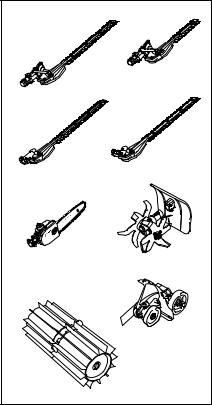
!Warning!
Never repair damaged cutting attachments by welding, straightening or modifying the shape. This may cause parts of the cutting tool to come off and result in serious or fatal injuries.
Keep the cutting tool sharp. Tighten all nuts, bolts and screws, except the carburetor adjustment screws, after each use.
Store the power tool in a dry and high or locked location out of reach of children.
Before storing for longer than a few days, always empty the fuel tank. See chapter "Storing the machine" in this manual.
English / USA
Approved Power Tool
Attachments
HL 0-90° |
FH |
|
|
||
HL 0° |
HL 30° |
|
|
BC 35 |
|
HT |
|
|
|
FCS |
|
KW |
KN |
|
393BA038 |
||
|
STIHL power tool attachments are available for converting the single purpose unit into other power tool combinations.
.
Power tool
attachment |
Application |
BC 35 1) 4) |
Cultivator |
FCS 2)4) |
Power edger |
FH 1) 4) |
Power scythe |
HL 0° 2) 3) |
Hedge cutter |
HL 0-90° 1) |
Hedge cutter |
HL 135° 1) |
Hedge cutter |
HT 2) 3) 4) |
Pole pruner |
KW 2) 4) |
PowerSweep |
1)Loop handle with barrier bar required
2)Barrier bar not necessary on loop handle
3)Loop handle is not necessary
4)Must not be mounted to versions with short drive tube (HL 100 K, HL 75 K)
HL 100 |
13 |
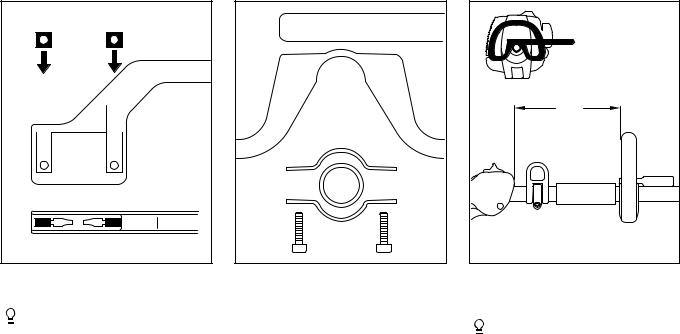
English / USA
Assembling the Unit
1 |
1 |
|
|
|
2 |
|
|
|
|
2 |
KN |
|
|
389BA001 |
|
1 |
1 |
|
|
|
|
|
Mounting the Loop Handle


 Necessary on versions with long shaft and 135° adjustable cutter bar (not HL 75 K, HL 100 K).
Necessary on versions with long shaft and 135° adjustable cutter bar (not HL 75 K, HL 100 K).
:Fit the square nuts (1) in the barrier bar (2) – the holes must line up.
|
2 |
|
|
4 |
|
|
3 |
|
|
5 |
|
|
6 |
KN |
|
|
|
7 |
7 |
389BA002 |
|
|
:Fit the clamp (3) in the loop handle (4) and place them both on the drive tube (5).
:Place clamp (6) in position and fit the barrier bar (2) so that the holes line up.
:Insert screws (7) and tighten them down moderately as far as stop against the barrier bar.
A |
4 |
389BA054 KN |
:Align the loop handle (4) and move it to the most comfortable position.


 Distance A must not be more than 21.5 in (55 cm) (about 14 in (35 cm) is recommended).
Distance A must not be more than 21.5 in (55 cm) (about 14 in (35 cm) is recommended).
:Tighten down the screws (7) firmly.
14 |
HL 100 |
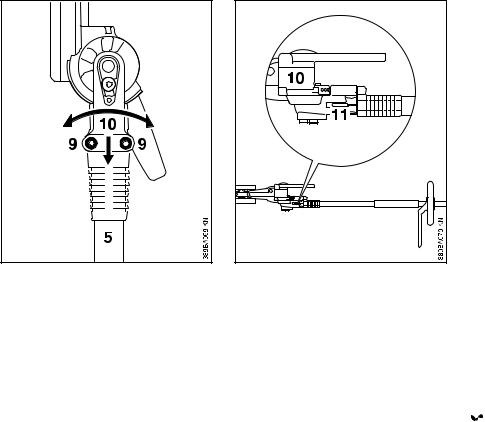
Mounting the Gearbox
:Loosen the clamp screws (9).
:Push the drive tube (5) into the gearbox (10) – turn the gearbox back and forth as necessary.
:Once the end of the drive tube is inserted beyond the slot in the clamp (11), push it fully home as far as stop.
:Fit the clamp screws and tighten down moderately.
:Line up the gearbox (10).
:Tighten down the clamp screws firmly.
English / USA
Using the Hedge Cutter
Do not use your hedge cutter during rest periods customary in the neigborhood.
Preparations
Use lopping shears to cut out thick branches first.
Always wear a harness..
Cutting sequence
If a radical cut is necessary, cut a little at a time in several stages.
Cutting techniques
Vertical cut:
Swing the cutter bar up and down in an arc as you move along the hedge – use both sides of the cutting blades.
Horizontal cut:
Hold the cutter bar at an angle of 0° to 10° as you swing the hedge cutter horizontally.
Swing the cutter bar in an arc towards the outside of the hedge so that the cuttings are swept on to the ground.

 Do not throw cuttings in the rubbish
Do not throw cuttings in the rubbish 
 bin (garbage can) – they can be composted!
bin (garbage can) – they can be composted!
HL 100 |
15 |
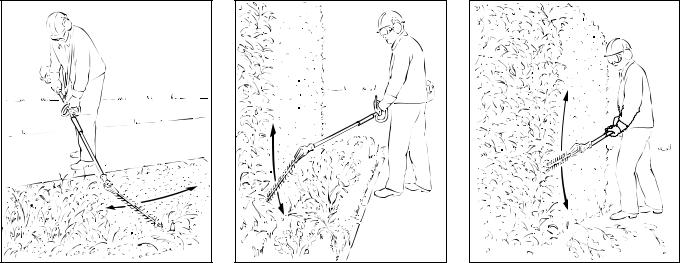
English / USA
389BA044 KN |
Horizontal cut
(with angled cutter bar)
Cutting close to the ground from a standing position, e.g. low shrubs (not with K version).
389BA049 KN |
Vertical cut
(with angled cutter bar)
Cutting without standing directly next to hedge, e.g. flowerbed between operator and hedge.
389BA050 KN |
Vertical cut
(with straight cutter bar)
Large working radius even without additional aids.
16 |
HL 100 |
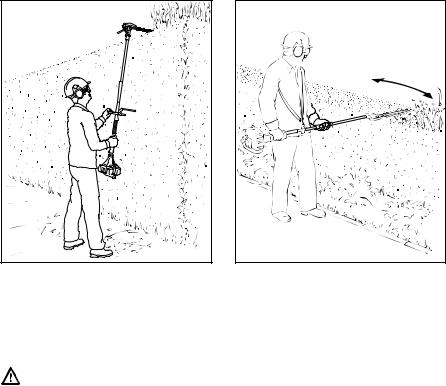
English / USA
4-MIX Engine
388BA000 KN |
389BA047 KN |
The STIHL 4-MIX engine features gas oil lubrication and must be run on a fuel mixture of gasoline and engine oil.
It operates otherwise on the 4-stroke principle.
Overhead cut
(with angled cutter bar)
Hold the hedge cutter vertically and swing it in an arc to make maximum use of its reach.
Any working position above head height is tiring. To minimize the risk of accidents, work in such positions for short periods only. Set angle of adjustable cutter bar to maximum so that the unit can be held in a lower, less tiring position (with harness) while still providing adequate vertical reach.
Horizontal cut
(with straight cutter bar)
Cutting without standing directly in front of the hedge, e.g. reaching over a flowerbed.
HL 100 |
17 |
English / USA
Fuel
This engine is certified to operate on unleaded gasoline and the STIHL twostroke engine oil at a mix ratio of 50:1.
Your engine requires a mixture of highquality gasoline and quality two-stroke air cooled engine oil.
Use mid-grade unleaded gasoline with a minimum octane rating of 89 (R+M/2). If the octane rating of the mid-grade gasoline in your area is lower, use premium unleaded fuel.
Fuel with a lower octane rating may increase engine temperatures. This, in turn, increases the risk of piston seizure and damage to the engine.
The chemical composition of the fuel is also important. Some fuel additives not only detrimentally affect elastomers (carburetor diaphragms, oil seals, fuel lines, etc.), but magnesium castings and catalytic converters as well. This could cause running problems or even damage the engine. For this reason STIHL recommends that you use only nationally recognized high-quality unleaded gasoline!
Use only STIHL two-stroke engine oil or equivalent high-quality two-stroke engine oils that are designed for use only in air cooled two-cycle engines.
We recommend STIHL 50:1 two-stroke engine oil since it is specially formulated for use in STlHL engines.
Do not use BIA or TCW rated (twostroke water cooled) mix oils or other mix oils that state they are for use in both water cooled and air cooled engines (e.g., outboard motors, snowmobiles, chainsaws, mopeds, etc.).
Take care when handling gasoline. Avoid direct contact with the skin and avoid inhaling fuel vapor. When filling at the pump, first remove the canister from your vehicle and place the canister on the ground before filling. Do not fill fuel canisters that are sitting in or on a vehicle.
The canister should be kept tightly closed in order to avoid any moisture getting into the mixture.
The machine‘s fuel tank and the canister in which fuel mix is stored should be cleaned as necessary.
Fuel mix ages
Only mix sufficient fuel for a few days work, not to exceed 3 months of storage. Store in approved fuel-canisters only. When mixing, pour oil into the canister first, and then add gasoline. Close the canister and shake it vigorously by hand to ensure proper mixing of the oil with the fuel.
Gaso- |
Oil (STIHL 50:1 or |
line |
equivalent high-quality oils) |
US gal. |
US fl.oz |
1 |
2.6 |
2 1/2 |
6.4 |
5 |
12.8 |
Dispose of empty mixing-oil canisters only at authorized disposal locations.
18 |
HL 100 |
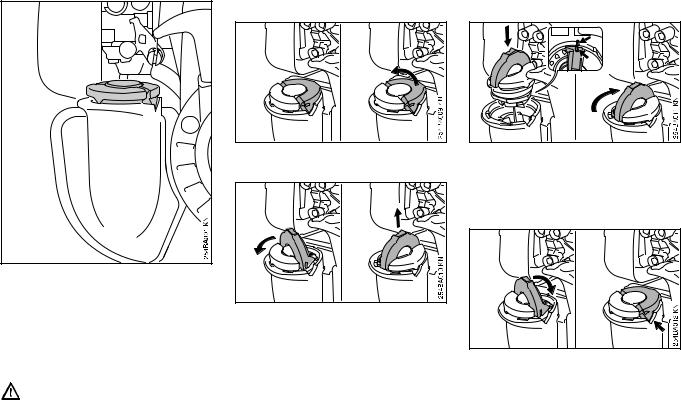
Fueling
Before fueling, clean the filler cap and the area around it to ensure that no dirt falls into the tank.
Always thoroughly shake the mixture in the canister before fueling your machine.
In order to reduce the risk of burns or other personal injury from escaping gas vapor and fumes, remove the fuel filler cap carefully so as to allow any pressure build-up in the tank to release slowly.
Opening the cap
:Raise the grip until it is upright.
:Turn the cap counterclockwise (approx. a quarter turn).
:Remove the filler cap.
English / USA
Closing the cap
:Fit the cap – grip upright –marks must line up.
:Turn the cap clockwise as far as stop (approx. a quarter turn).
:Fold the grip flush with the top of the cap.
:If the grip does not lie completely flush with the cap and the detent on the grip does not engage the recess in the filler neck, the cap is not properly seated and tightened and you must repeat the above steps.
HL 100 |
19 |
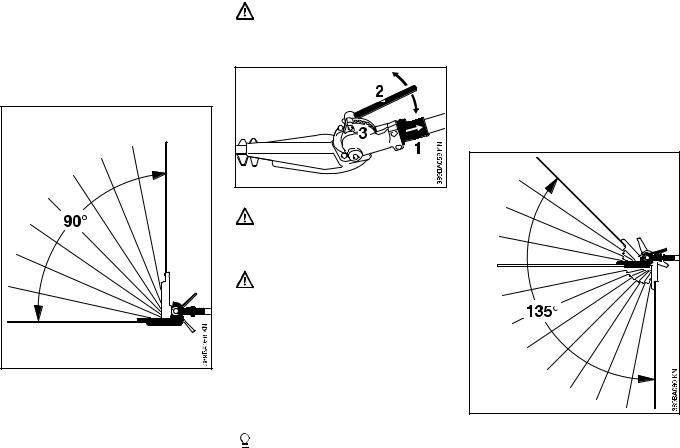
English / USA
Adjusting Cutter Bar
0° to 90° Version
On this version the angle of the cutter bar can be adjusted in 8 stages between 0° (straight) and 90° (upwards at right angle. There are therefore 9 possible working positions.
Carry out the adjustment only when the cutting blades are at a standstill
– engine at idle speed – not in the starting throttle position.
The gearbox becomes hot during operation. To reduce the risk of burn injury, do not touch the gear housing.
To avoid risk of injury, never touch the blades while making adjustments.
:Pull back the sliding sleeve (1) and use the lever (2) to adjust the joint by one or several holes.
:Release the sliding sleeve and make sure the pin engages the quadrant (3).


 The sliding sleeve butts against the housing when the pin is properly engaged (after making adjustment).
The sliding sleeve butts against the housing when the pin is properly engaged (after making adjustment).
0° to 135° Version
On this version the angle of the cutter bar can be adjusted upwards in 4 stages from 0° (straight) to 45°, and downwards in 8 stages from 0° to 90° (right angle facing down). There are therefore 13 possible working positions.
There is also a special transport position.
20 |
HL 100 |
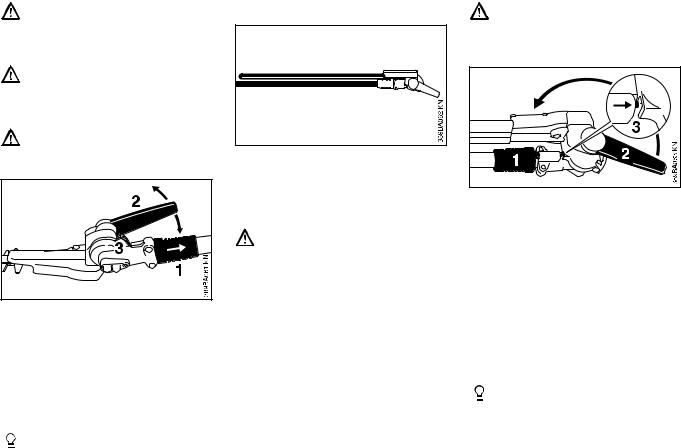
English / USA
Carry out the adjustment only when the cutting blades are at a standstill
– engine at idle speed – not in the starting throttle position.
The gearbox becomes hot during operation. To reduce the risk of burn injury, do not touch the gear housing.
To avoid risk of injury, never touch the blades while making adjustments.
:Pull back the sliding sleeve (1) and use the lever (2) to adjust the joint by one or several holes.
:Release the sliding sleeve and make sure the pin engages the quadrant (3).


 The sliding sleeve butts against the housing when the pin is properly engaged (after making adjustment).
The sliding sleeve butts against the housing when the pin is properly engaged (after making adjustment).
Transport Position
The cutter bar on this version can be folded flat against the drive tube and locked in position to save space during transportation.
Always shut off the engine – slide control to STOP – and fit the blade scabbard before moving the cutter bar to the transport position or from the transport position to the normal working position.
The gearbox becomes hot during operation. To reduce the risk of burn injury, do not touch the gear housing.
:Shut off the engine.
:Fit the blade scabbard.
:Pull back the sliding sleeve (1) and use the lever (2) to swing the joint upwards – in direction of drive tube
– until the cutter bar is flat against the drive tube.
:Release the sliding sleeve and make sure the lock pin engages the housing (3).


 The sliding sleeve butts against the housing when the pin is properly engaged (after making adjustment).
The sliding sleeve butts against the housing when the pin is properly engaged (after making adjustment).
HL 100 |
21 |
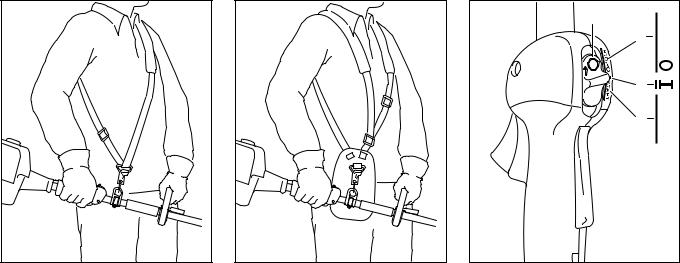
English / USA |
|
Fitting the Harness |
Starting / Stopping |
|
the Engine |
1 |
3 |
389BA055 KN |
Shoulder strap
:Put on the shoulder strap (1).
:Adjust length until the spring hook
(3) rests against your right hip.
2 |
3 |
389BA056 KN |
Full harness*
:Put on the full harness (2).
:Adjust length until the spring hook
(3) rests against your right hip.
*see "Guide to Using this Manual"
7 |
|
-STOP |
|
4 |
|
|
|
|
STOP |
|
|
3 |
5 |
START |
|
||
|
6 |
|
|
|
2
1
002BA181 KN
Controls
Throttle trigger interlock (1), throttle trigger (2) and slide control (3).
Positions of Slide Control
STOP-O (4) – engine off – the ignition is switched off
# – normal run position (5) – the engine is running or can start
START (6) – the ignition is switched on, the engine can start
22 |
HL 100 |
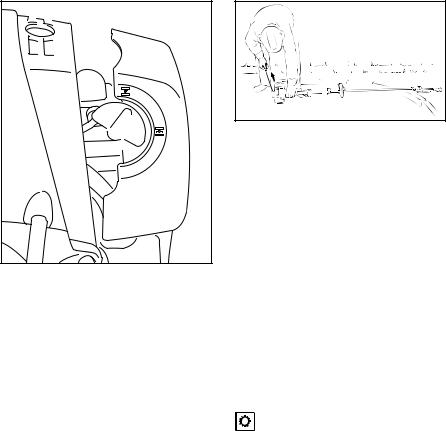
English / USA
Symbol on slide control
h (7) – stop symbol and arrow – to stop the engine, push the slide control in direction of the arrow on the stop symbol (h) to STOP-O.
Starting Procedure
:Hold down the throttle trigger interlock and squeeze the throttle trigger.
:While holding both levers in this position, move slide control to START and hold it there.
:Now release the throttle trigger, slide control and throttle trigger interlock in that order. This is the starting throttle position.
9
 8
8
249BA007 KN
:Set the choke knob (8):
For cold start to g
For warm start to e
Also use this setting if engine has been running but is still cold.
:Press fuel pump bulb (9) at least five times – even if the bulb is filled with fuel.
389BA013 KN |
:Place the unit on the ground: It must rest securely on the engine support and the gearbox.
:On units with an adjustable cutter bar and defined transport positon: Set the cutter bar to the straight (0°) position.
:Remove the blade scabbard. Check that the cutting blades are not touching the ground or any other obstacles. If necessary, rest the gearbox on a raised support (e.g. a mound, brick or something similar).
:Make sure you have a firm footing: Press the unit firmly against the ground with your left hand. Your thumb should be under the fan housing.
 Do not stand or kneel on the drive tube. This will bend the tube
Do not stand or kneel on the drive tube. This will bend the tube
and result in permanent damage to the drive tube.
HL 100 |
23 |
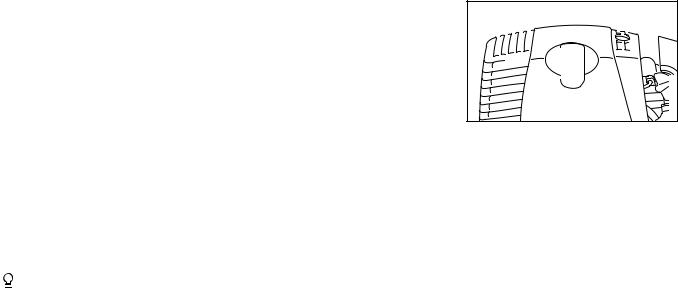
English / USA
:Pull the starter grip slowly with your right hand until you feel it engage – and then give it a brisk strong pull. Do not pull out starter rope to full length – it might break.
:Do not let the starter grip snap back
– guide it slowly into the housing so that the starter rope can rewind properly.
:Crank until the engine begins to fire. Move the choke knob to e after no more than five pulls.
:Continue cranking.
As soon as engine runs:
:Blip the throttle trigger – the slide control moves to the run position #, and the engine returns to idling speed.


 Make sure carburetor is correctly adjusted – the cutting blades must not move when the engine is idling.
Make sure carburetor is correctly adjusted – the cutting blades must not move when the engine is idling.
Your machine is now ready for operation.
To shut down the engine
:Push the slide control in the direction of the arrow on the stop symbol (h) to STOP-O.
At very low temperatures
As soon as engine runs:
:Blip the throttle trigger – the slide control moves to the run position #, and the engine returns to idling speed.
:Open throttle slightly.
:Warm up engine for short period.
If the engine does not start:
Choke knob
If you did not move the choke to e quickly enough after the engine began to fire, the combustion chamber is flooded.
:Set choke knob to e
:Set slide control, interlock lever and throttle trigger to the starting throttle position
:Start the engine – pull the starter rope briskly – 10 to 20 pulls may be necessary.
If the engine still does not start:
 10
10
KN249BA008
:Move the slide control to STOP – 0
:Pull off the spark plug boot (10).
:Unscrew and dry off the spark plug.
:Open the throttle fully.
:Pull the starter rope several times to clear the combustion chamber.
:Refit the spark plug.
:Connect the spark plug boot and press it down firmly.
:Move the slide control to START
:Set choke knob to e even if engine is cold.
:Now start the engine.
24 |
HL 100 |
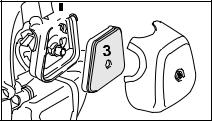
Throttle cable adjustment
:Check adjustment of throttle cable – see "Adjusting the Throttle Cable".
Fuel tank run until dry
:After refueling, press the fuel pump bulb at least fives times – even if the bulb is filled with fuel.
:Set choke knob to suit engine temperature.
:Now start the engine.
Operating Instructions
During break-in period
A factory new machine should not be run at high revs (full throttle off load) for the first three tank fillings. This avoids unnecessary high loads during the break-in period. As all moving parts have to bed in during the break-in period, the frictional resistances in the engine are greater during this period. The engine develops its maximum power after about 5 to 15 tank fillings.
During operation
After a long period of full-throttle operation, allow engine to run for a while at idle speed so that the heat in the engine can be dissipated by flow of cooling air. This protects enginemounted components (ignition, carburetor) from thermal overload.
After finishing work
Wait for engine to cool down. Drain the fuel tank. Store the machine in a dry place. Check tightness of nuts and screws (not adjusting screws) at regular intervals and retighten as necessary.
English / USA
Cleaning the Air Filter

 4
4
1 |
KN |
2 |
266BA009 |
|
Dirty air filters reduce engine power, increase fuel consumption and make starting more difficult.
If there is a noticeable loss of engine power:
:Set the choke knob to g.
:Take out the screw (1) and remove the filter cover (2).
:Clean away loose dirt from around the filter.
:Grip the filter element (3) at the notch (arrow) in the filter housing (4) and take it out.
:Fit a new filter element. As a temporary measure you can knock it out on the palm of your hand or blow it out. Do not wash.
:Replace any damaged parts.
:Install filter element in the filter housing.
:Refit the filter cover.
:Insert the screw and tighten it down firmly.
HL 100 |
25 |
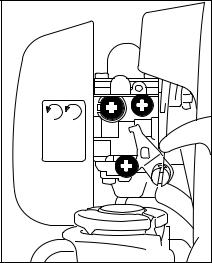
English / USA |
|
Motor Management |
Adjusting the Carburetor |
Exhaust emissions are controlled by the design of the fundamental engine parameters and components (e.g. carburation, ignition, timing and valve or port timing) without the addition of any major hardware.
H |
L |
3/4 |
3/4 |
LA |
|
|
249BA032 KN |
The carburetor comes from the factory with a standard setting.
This setting provides an optimum fuel-air mixture under most operating conditions.
With this carburetor it is only possible to adjust the high speed and low speed screws within fine limits.
Standard Setting
:Shut off the engine.
:Inspect cutting blades and clean if necessary (they must be clean, move freely and not be warped).
:Check that throttle cable is properly adjusted – readjust if necessary – see chapter on "Adjusting the Throttle Cable".
:Check spark arresting screen (not fitted in all markets) and clean or replace as necessary.
:Check the air filter and clean or replace as necessary.
:Carefully turn both adjusting screws counterclockwise as far as the stop:
The high speed screw (H) and low speed screw (L) are now 3/4 turn open.
:Start and warm up the engine.
:Adjust idle speed with the idle speed screw (LA) so that the cutting blades do not run.
26 |
HL 100 |
